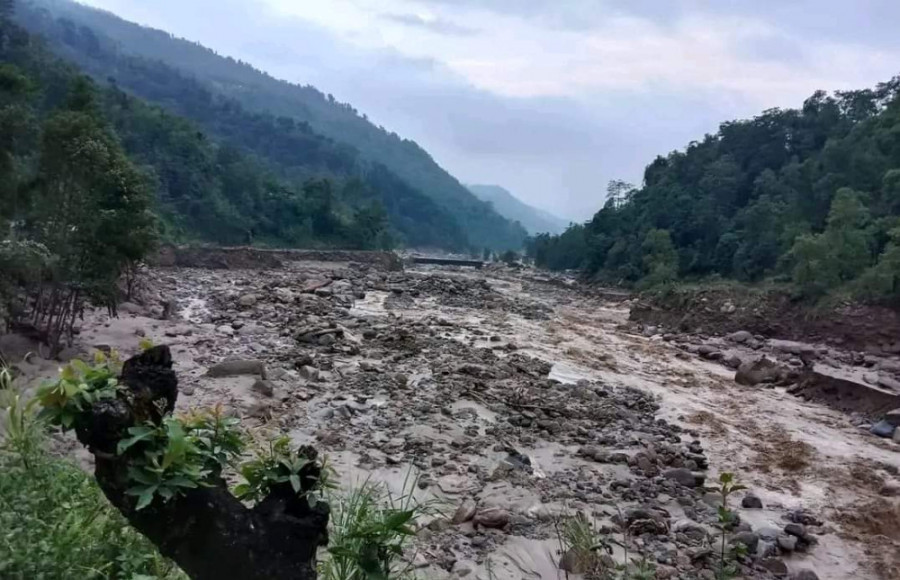Climate & Environment
Climate change adds risk to investments in hydropower
At least 30 projects in east suffered damage worth Rs8.5 billion due to floods and landslides in season’s first rains.
Arjun Poudel
Sumuna Shrestha, deputy mayor of Panchkhapan Municipality of Sankhuwasabha district, had never seen such havoc caused by flooding in 63 years of her life.
At least three persons died and 18 others went missing in a June 17 flood in the municipality. Most of the deceased and the missing were labourers, working on hydel projects being built on the local Hewa Khola.
“In 2015 too, a flood in Hewa Khola caused damage to arable land but it was not as devastating as this one,” Shrestha told the Post over the phone from Sankhuwasabha. “Life in our area has not been normal since.”
Apart from widespread damage to roads, bridges, and public properties, hydel projects (both in operation and under construction) in the flood and landslide-hit districts of Koshi Province—Sankhuwasabha, Panchthar, Bhojpur and Taplejung—incurred massive damage.
Hydropower is not only the main source of energy in the country but also has huge export potential. The government aims to export 10,000 megawatts of electricity in the next 10 years.
But the erratic weather patterns—extreme rainfall in a short span of time, lack of rains for months, continued rain for several days and other unusual weather events—caused by climate change have become frequent in Nepal, affecting thousands of people and threatening the country’s hydropower potential.
According to the Independent Power Producers Association of Nepal (IPPAN), the Hewa Khola Hydropower Project was built by analysing the past 100 years’ data on the river’s normal flow and floods.
“The authorities, including the Department of Hydrology and Meteorology, do not have flood data of the past 100 years on all rivers,” said Ganesh Karki, chairman of the association. “They have data of Hewa Khola, which was analysed and the project was built accordingly. But what can one do, when a flood of such intensity, which was not seen in the last 100 years, comes? Elderly people of 80 to 90 years from Panchkhapan Municipality say they have not seen such devastating floods in their lifetime.”
Climate scientists say building hydel projects on the basis of 100 years’ water data doesn’t ensure their safety, as weather extremes have been escalating due to the effects of climate change. They say erratic weather patterns have become frequent in Nepal.
“Almost all sectors, including our hydel projects, have been affected by climate extremes,” said Manjeet Dhakal, climate change expert. “Along with past data, the effects of climate change should be analysed while building big projects. Our infrastructures should be made compatible with possible adverse effects of climate change.”
At least 30 hydropower projects in eastern Nepal suffered damage estimated at around Rs8.5 billion due to floods and landslides during the first spell of the monsoon.
“The estimated loss amount is a direct loss, ” said Karki, chairman of the association. “Indirect losses will be several times higher.”
Of the 30 projects with combined rated capacity of 463 megawatts, 13 projects totalling 132 megawatts were in operation and they incurred Rs 6 billion in direct losses. Karki says it takes several months to resume the operations of hydropower projects and the delay hits their revenues. The duration of project-construction is also extended.
This in turn calls for more investment, but the banks will not waive off interest. Moreover, the duration of the licence period will be shortened, which means investors will not be able to make the desired profit.
“Due to a prolonged drought in the winter, production of almost all hydel projects was reduced to around 30 percent of the total capacity,” complained Karki. “Floods and landslides at the onset of monsoon severely damaged projects under construction as well as those in operation.”
Any hydropower generation project has to be handed over to the government in good running condition after the expiry of the licence period.
Dhakal said that the agencies concerned, including investors, should study the latest climate report of the United Nations before jumping into such projects.
The sixth assessment report of the Intergovernmental Panel on Climate Change (IPCC), composed of the world’s leading climate scientists, stated that the global surface temperature has increased faster since 1970 than in any other 50-year period over at least the past 2,000 years.
According to the report, climate change and related extreme events will affect future energy systems, including hydropower production, bioenergy yields, thermal power plant efficiencies, and demands for heating and cooling.
“The most feasible energy system adaptation options support infrastructure resilience, reliable power systems and efficient water use for existing and new energy generation systems,” said the report. “Adaptations for hydropower and thermo-electric power generation are effective in most regions up to 1.5°C to 2°C, with decreasing effectiveness at higher levels of warming.”
The report recommended energy generation diversification—wind, solar, small-scale hydroelectric and demand-side management. Storage and energy efficiency improvements can increase energy reliability and reduce vulnerabilities to climate change, it added.
“The frequency of extreme weather events has increased and climate patterns have changed, which have both short- and long-term consequences,” said Dr Indira Kandel, a senior divisional meteorologist at the Climate Analysis Section under the Department of Hydrology and Meteorology.
“We should be more mindful of the possible impact of climate change while undertaking future development activities. Along with analysing past data, it will be important t0 map out future weather forecasts.”




 11.12°C Kathmandu
11.12°C Kathmandu








%20(1).jpg&w=300&height=200)

